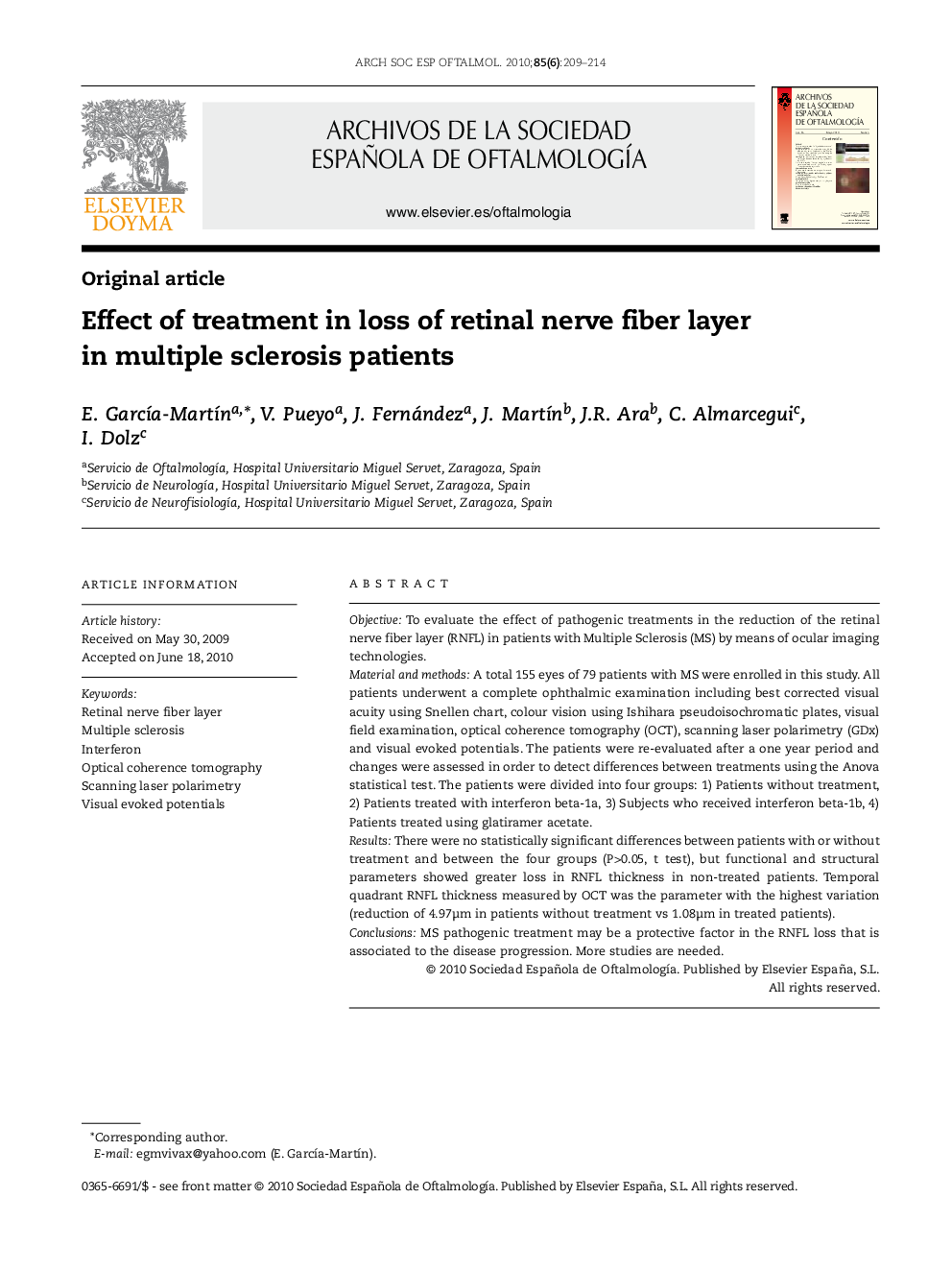| Article ID | Journal | Published Year | Pages | File Type |
|---|---|---|---|---|
| 4008848 | Archivos de la Sociedad Española de Oftalmología (English Edition) | 2010 | 6 Pages |
ObjectiveTo evaluate the effect of pathogenic treatments in the reduction of the retinal nerve fiber layer (RNFL) in patients with Multiple Sclerosis (MS) by means of ocular imaging technologies.Material and methodsA total 155 eyes of 79 patients with MS were enrolled in this study. All patients underwent a complete ophthalmic examination including best corrected visual acuity using Snellen chart, colour vision using Ishihara pseudoisochromatic plates, visual field examination, optical coherence tomography (OCT), scanning laser polarimetry (GDx) and visual evoked potentials. The patients were re-evaluated after a one year period and changes were assessed in order to detect differences between treatments using the Anova statistical test. The patients were divided into four groups: 1) Patients without treatment, 2) Patients treated with interferon beta-1a, 3) Subjects who received interferon beta-1b, 4) Patients treated using glatiramer acetate.ResultsThere were no statistically significant differences between patients with or without treatment and between the four groups (P>0.05, t test), but functional and structural parameters showed greater loss in RNFL thickness in non-treated patients. Temporal quadrant RNFL thickness measured by OCT was the parameter with the highest variation (reduction of 4.97μm in patients without treatment vs 1.08μm in treated patients).ConclusionsMS pathogenic treatment may be a protective factor in the RNFL loss that is associated to the disease progression. More studies are needed.
ResumenObjetivosEvaluar el efecto del tratamiento patogénico de la esclerosis múltiple (EM) sobre la pérdida de fibras nerviosas de la retina (CFNR) mediante técnicas de análisis digital de imagen.Material y métodoSe incluyeron 155 ojos de 79 pacientes con EM, a los que se exploró la agudeza visual medida con optotipos de Snellen, el defecto de refracción y la visión de colores, y se realizó perimetría automatizada, tomografía de coherencia óptica (OCT), polarimetría láser (GDx) y potenciales evocados visuales (PEV). Este protocolo se repitió al año y los cambios observados fueron comparados según el tratamiento asignado mediante el test de Anova; para lo que se dividió la población en 4 grupos en función del tratamiento recibido: 1) sin tratamiento, 2) interferón beta 1a, 3) interferón beta 1b, 4) acetato de glatirámero.ResultadosNo se detectaron diferencias significativas (test t, p > 0,05) entre los pacientes con o sin tratamiento ni entre los 4 grupos, pero la mayoría de los parámetros funcionales y estructurales mostraron una tendencia a presentar mayores reducciones de la CFNR en el grupo sin tratamiento. La mayor variación apareció en el cuadrante temporal de la CFNR en la OCT (reducción de 4,97 μm en pacientes sin tratamiento vs 1,08 μm en los tratados).ConclusiónEl tratamiento patogénico de la EM puede ser un factor protector para la reducción del espesor de la CFNR que se produce con la progresión de la enfermedad. Se necesitan más estudios.
